Study on Water Saving Potential and Net Profit of Zea mays L.: The Role of Surface Mulching with Micro-Spray Irrigation
Abstract
:1. Introduction
2. Materials and Methods
2.1. Experimental Site
2.2. Test Design
2.3. Irrigation Scheme
2.4. Field Management
2.5. Climate Data
2.6. Measurement of Indicators
2.7. Data Collations and Statistical Methods
3. Results
3.1. Changes in the Soil Temperature and the Soil Water Content
3.2. Water Saving Potential (Per Unit Yield and Per Unit Area)
3.3. Light and Temperature Production Potential, Yield and Water Consumption
3.4. Economic Profits
4. Discussion
4.1. Water Saving Potential
4.2. Yield and Water Consumption
4.3. Economic Profits
5. Conclusions
Author Contributions
Funding
Acknowledgments
Conflicts of Interest
Abbreviations
| ETo | REFERENCE CROP EVAPOTRANSPIRATION |
| ETc | WATER CONSUMPTION |
| FAO | FOOD AND AGRICULTURE ORGANIZATION |
| JG | STRAW MULCHING |
| NF | ORGANIC MANURE MULCHING |
| Py | WATER SAVING POTENTIAL PER UNIT YIELD |
| Sp | WATER SAVING POTENTIAL PER UNIT AREA |
| WG | NO MULCHING |
| WUE | WATER USE EFFICIENCY |
| Yc | LIGHT AND TEMPERATURE PRODUCTION POTENTIAL |
References
- He, Q.; Zhou, G. Climate-associated distribution of summer maize in China from 1961 to 2010. Agri. Ecosyst. Environ. 2016, 232, 326–335. [Google Scholar] [CrossRef]
- Forouzani, M.; Karami, E. Agricultural water poverty index and sustainability. Agron. Sustain. Dev. 2011, 31, 415–432. [Google Scholar] [CrossRef] [Green Version]
- Foley, J.A.; Ramankutty, N.; Brauman, K.A.; Cassidy, E.S.; Gerber, J.S.; Johnton, M.; Mueller, N.D.; O′Connell, C.; Ray, D.K.; West, P.C.; et al. Solutions for a cultivated planet. Nature 2011, 478, 337–342. [Google Scholar] [CrossRef] [PubMed] [Green Version]
- Chai, Q.; Gan, Y.; Turner, N.C. Water-saving innovations in Chinese agriculture. Adv. Agron. 2014, 126, 147–197. [Google Scholar]
- Kaur, A.; Brar, A.S. Influence of mulching and irrigation scheduling on productivity and water use of turmeric (Curcuma longa L.) in north-western India. Irrigation Sci. 2016, 34, 261–269. [Google Scholar]
- Uzoma, K.C.; Inoue, M.; Andry, H.; Fujimaki, H. Effect of cow manure biochar on maize productivity under sandy soil condition. Soil Use Manag. 2011, 27, 205–212. [Google Scholar] [CrossRef]
- Gan, Y.T.; Siddique, K.H.M.; Turner, N.C. Ridge–furrow mulching systems-an innovative technique for boosting crop productivity in semiarid rain-fed environments–chapter seven. Adv. Agron. 2013, 118, 429–476. [Google Scholar]
- Wang, X.; Jia, Z.; Liang, L. Impacts of manure application on soil environment, rainfall use efficiency and crop biomass under dryland farming. Sci. Rep. 2016, 6, 20994. [Google Scholar] [CrossRef] [Green Version]
- Hengsdijk, H.; Wang, G.H.; Van den Berg, M.M.; Wang, J.D.; Wolf, J.; Changhe, L.; Roetter, R.P.; Van Keulen, H. Poverty and biodiversity trade-offs in rural development: A case study for Pujiang County, China. Agric. Syst. 2007, 94, 851–861. [Google Scholar] [CrossRef]
- Li, Z.X.; Dong, S.T.; Hu, C.H.; Wang, K.J.; Zhang, J.W.; Liu, P. Influence of organic manure and inorganic manure interaction on yield of maize and characteristic of topsoil. J. Maize Sci. 2004, 12, 100–102. [Google Scholar]
- Huang, Q.; Rozelle, S.; Lohmar, B.; Huang, J.; Wang, J. Irrigation, agricultural performance and poverty reduction in China. Food Policy 2006, 31, 30–52. [Google Scholar] [CrossRef] [Green Version]
- Gao, Q.Z.; Du, H.L.; Zu, R.P. The balance between supply and demand of water resources and the water-saving potential for agriculture in the Hexi Corridor. Chin. Geogr. Sci. 2002, 12, 23–29. [Google Scholar] [CrossRef]
- Guang, X.Z.; Wei, D. The groundwater crisis and sustainable agriculture in northern China. Water Eng. Manag. 2002, 149, 13–16. [Google Scholar]
- Wang, C.; Wang, J.; Xu, D.; Sui, J.; Mo, Y. Water consumption patterns and crop coefficient models for drip-irrigated maize (Zea mays L.) with plastic mulching in northeastern China. Trans. ASABE 2019, 62, 571–584. [Google Scholar] [CrossRef]
- Li, Y.; Yang, X.G.; Dai, S.W.; Wang, W.F. Spatiotemporal change characteristics of agricultural climate resources in middle and lower reaches of Yangtze River. Chin. J. Appl. Ecol. 2010, 21, 2912–2921. [Google Scholar]
- Kang, S.Z.; Yang, J.Z.; Pei, Y.S.; Feng, S.Y.; Huo, Z.L.; Sun, J.S.; Zhang, X.Y.; Wu, J.W.; Wang, J.L.; Tong, L.; et al. Farmland Water Cycle Process and Agricultural Efficient Water Use Mechanism in Hai River Basin; Science Press: Beijing, China, 2013; pp. 204–252. [Google Scholar]
- Yue, Q.; Zhang, F.; Guo, P. Optimization-Based Agricultural Water-Saving Potential Analysis in Minqin County, Gansu Province China. Water 2018, 10, 1125. [Google Scholar] [CrossRef] [Green Version]
- Pfeiffer, L.; Lin, C.Y.C. Does efficient irrigation technology lead to reduced groundwater extraction? Empirical evidence. J. Environ. Econ. Manag. 2014, 67, 189–208. [Google Scholar] [CrossRef] [Green Version]
- Christian-Smith, J.; Cooley, H.; Gleick, P.H. Potential water savings associated with agricultural water efficiency improvements: A case study of California, USA. Water Policy 2012, 14, 194. [Google Scholar] [CrossRef]
- Liu, L.G.; Cui, Y.L.; Wang, J.P. New calculation method for water saving potential in agriculture based on water balance principle. Adv Water Sci. 2011, 22, 696–702. [Google Scholar]
- Evett, S.R.; Schwartz, R.C.; Howell, T.A.; Louis Baumhardt, R.; Copeland, K.S. Can weighing lysimeter ET represent surrounding field ET well enough to experiment flux station measurements of daily and sub-daily ET? Adv. Water Resour. 2012, 50, 79–90. [Google Scholar] [CrossRef]
- Liu, H.L.; Yang, J.Y.; Tan, C.S.; Drury, C.F.; Reynolds, W.D.; Zhang, T.Q.; Bai, Y.L.; Jin, J.; He, P.; Hoogenboom, G. Simulating water content, crop yield and nitrate-N loss under free and controlled tile drainage with subsurface irrigation using the DSSAT model. Agric. Water Manag. 2011, 98, 1105–1111. [Google Scholar] [CrossRef]
- Rodríguez, M.M.; Sáez Fernández, F.J.; Aragón Correa, J.A. Evaluation of irrigation projects and water resource management: A methodological proposal. Sustain. Dev. 2002, 10, 13. [Google Scholar] [CrossRef]
- Ram, H.; Dadhwal, V.; Vashist, K.K. Grain yield and water use efficiency of wheat (Triticum aestivum L.) in relation to irrigation levels and rice straw mulching in North West India. Agric. Water Manag. 2013, 128, 92–101. [Google Scholar] [CrossRef]
- Li, Q.S.; Willardson, L.S.; Deng, W.; Li, X.J.; Liu, C.J. Crop water deficit estimation and irrigation scheduling in western Jilin province, Northeast China. Agric. Water Manag. 2005, 71, 47–60. [Google Scholar] [CrossRef]
- Xiao, J.F.; Liu, Z.D.; Chen, Y.M. Study on the Water requirement and water requirement regulation of maize in China. J. Maize Sci. 2008, 16, 21–25. [Google Scholar]
- Yazar, A.; GökçEl, F.; Sezen, M.S. Maize yield response to partial root zone drying and deficit irrigation strategies applied with drip system. Plant. Soil Environ. 2009, 55, 494–503. [Google Scholar] [CrossRef] [Green Version]
- Rana, G.; Katerji, N. Measurement and estimation of actual evapotranspiration in the field under Mediterranean climate: A review. Eur. J. Agron. 2000, 13, 125–153. [Google Scholar] [CrossRef]
- Scott, H.D. Soil physics: Agricultural and environmental applications. Soil Sci. 2001, 166, 717–718. [Google Scholar]
- Griggs, D.J.; Noguer, M. Climate change 2001: The scientific basis. contribution of working group I to the third assessment report of the intergovernmental panel on climate change. Weather 2010, 57, 267–269. [Google Scholar] [CrossRef]
- Mueller, N.D.; Gerber, J.S.; Johnston, M. Closing yield gaps through nutrient and water management. Nature 2012, 490, 254–257. [Google Scholar] [CrossRef]
- Sharma, P.; Abrol, V.; Sankar, G.M. Influence of tillage practices and mulching options on productivity, economics and soil physical properties of maize (Zea mays)-wheat (Triticum aestivum) system. Indian J. Agr. Sci. 2011, 79, 865–870. [Google Scholar]
- Zhao, Y.; Pang, H.; Wang, J.; Huo, L.; Li, Y. Effects of straw mulch and buried straw on soil moisture and salinity in relation to sunflower growth and yield. Field Crop. Res. 2014, 161, 16–25. [Google Scholar] [CrossRef]
- Teame, G.; Tsegay, A.; Abrha, B. Effect of organic mulching on soil moisture, yield, and yield contributing components of sesame (Sesamum indicum L.). Int. J. Agron. 2017, 2017, 6–12. [Google Scholar] [CrossRef] [Green Version]
- Zhao, H.; Zhu, Y.; Man, L.; Yang, H.W. The correlation of light-temperature indexes and light-temperature potential productivity of spring maize. In Proceedings of the International Conference on Geoinformatics, Wuhan, China, 19–21 June 2016; pp. 1–6. [Google Scholar]
- Costa, A.C.T.D.; Oliveira, L.B.D.; Carmo, M.G.F.D. Rust quantification by visual and photosynthetic potential evaluation and its correlations with production in families of pearl millet. Trop. Plant. Pathol. 2009, 34, 313–321. [Google Scholar]
- Gao, Y.N.; YU, G.R.; Yan, H.M.; Zhu, X.J.; Li, S.G.; Wang, Q.F.; Zhang, J.H.; Wang, Y.F.; LI, W.N.; Zhao, L.; et al. A MODIS-based photosynthetic capacity model to estimate gross primary production in Northern China and the tibetan plateau. Remote Sens. Environ. 2014, 148, 108–118. [Google Scholar] [CrossRef]
- Zhou, W.D.; Zhu, J.H.; Wang, Y.Q.; Li, Y. Change characteristics of Shanghai’s agroclimatic resources in the last hundred years. Resour. Sci. 2008, 30, 642–647. [Google Scholar]
- Eduardo, D.O.A.L.; Moreto, V.B.; Glauco, D.S.R. Climatic potential for summer and winter wine production. J. Sci. Food Agr. 2018, 98, 1280–1290. [Google Scholar]
- Li, Q.; Li, H.; Zhang, S. Yield and water use efficiency of dryland potato in response to plastic film mulching on the Loess Plateau. Acta Agr. Scand. Sect. B Soil Plant Sci. 2018, 68, 175–188. [Google Scholar] [CrossRef]
- Yin, W.; Fan, Z.L.; Hu, F.L.; Yu, A.Z.; Zhao, C.; Chai, Q.; Coulter, J.A. Innovation in alternate mulch with straw and plastic management bolsters yield and water use efficiency in wheat-maize intercropping in arid conditions. Sci. Rep. 2019, 9, 6364. [Google Scholar] [CrossRef]
- Gao, Y.; Li, Y.; Zhang, J. Effects of mulch, N fertilizer, and plant density on wheat yield, wheat nitrogen uptake, and residual soil nitrate in a dryland area of China. Nutr. Cycl. Agroecosys. 2009, 85, 109–121. [Google Scholar] [CrossRef]
- Yin, W.; Feng, F.; Zhao, C.; Yu, A.Z.; Hu, F.L.; C, Q. Integrated double mulching practices optimizes soil temperature and improves soil water utilization in arid environments. Int. J. Biometeorol. 2016, 60, 1423–1437. [Google Scholar] [CrossRef]
- Brar, A.S.; Buttar, G.S.; Thind, H.S.; Singh, K.B. Improvement of Water Productivity, Economics and Energetics of Potato through Straw Mulching and Irrigation Scheduling in Indian Punjab. Potato Res. 2019, 6, 1–20. [Google Scholar] [CrossRef]
- Sun, H.; Shao, L.; Liu, X.W.; Miao, W.F.; Chen, S.Y.; Zhang, X.Y. Determination of water consumption and the water-saving potential of three mulching methods in a jujube orchard. Eur. J. Agron. 2012, 43, 87–95. [Google Scholar] [CrossRef]
- Zhou, B.Y.; Ma, D.; Sun, X.F.; Ding, Z.S.; Li, C.F.; Ma, W.; Zhao, M. Straw mulching under a drip irrigation system improves maize grain yield and water use efficiency. Crop. Sci. 2019, 59, 2806–2819. [Google Scholar] [CrossRef]
- Feinerman, E. Groundwater management: Efficiency and equity considerations. Agr. Econ. Blackwell. 1988, 2, 1–18. [Google Scholar] [CrossRef]
- Jabran, K.; Hussain, M.; Fahad, S.; Farooq, M.; Bajwa, A.A.; Alharrby, H.; Nasim, W. Economic assessment of various mulches in conventional and water-saving rice production systems. Environ. Sci. Pollut. R. 2016, 23, 9156. [Google Scholar] [CrossRef] [PubMed]
- Wang, Z.; Li, Y.K.; Guo, W.Z. Yield, nitrogen use efficiency and economic benefits of biochar additions to Chinese Flowering Cabbage in Northwest China. Nutr. Cycl. Agroecosys. 2019, 113, 337–348. [Google Scholar] [CrossRef]
- Halloran, J.M.; Griffin, T.S.; Honeycutt, C.W. An economic analysis of potential rotation crops for Maine potato cropping systems. Am. J. Potato Res. 2005, 82, 155–162. [Google Scholar] [CrossRef]

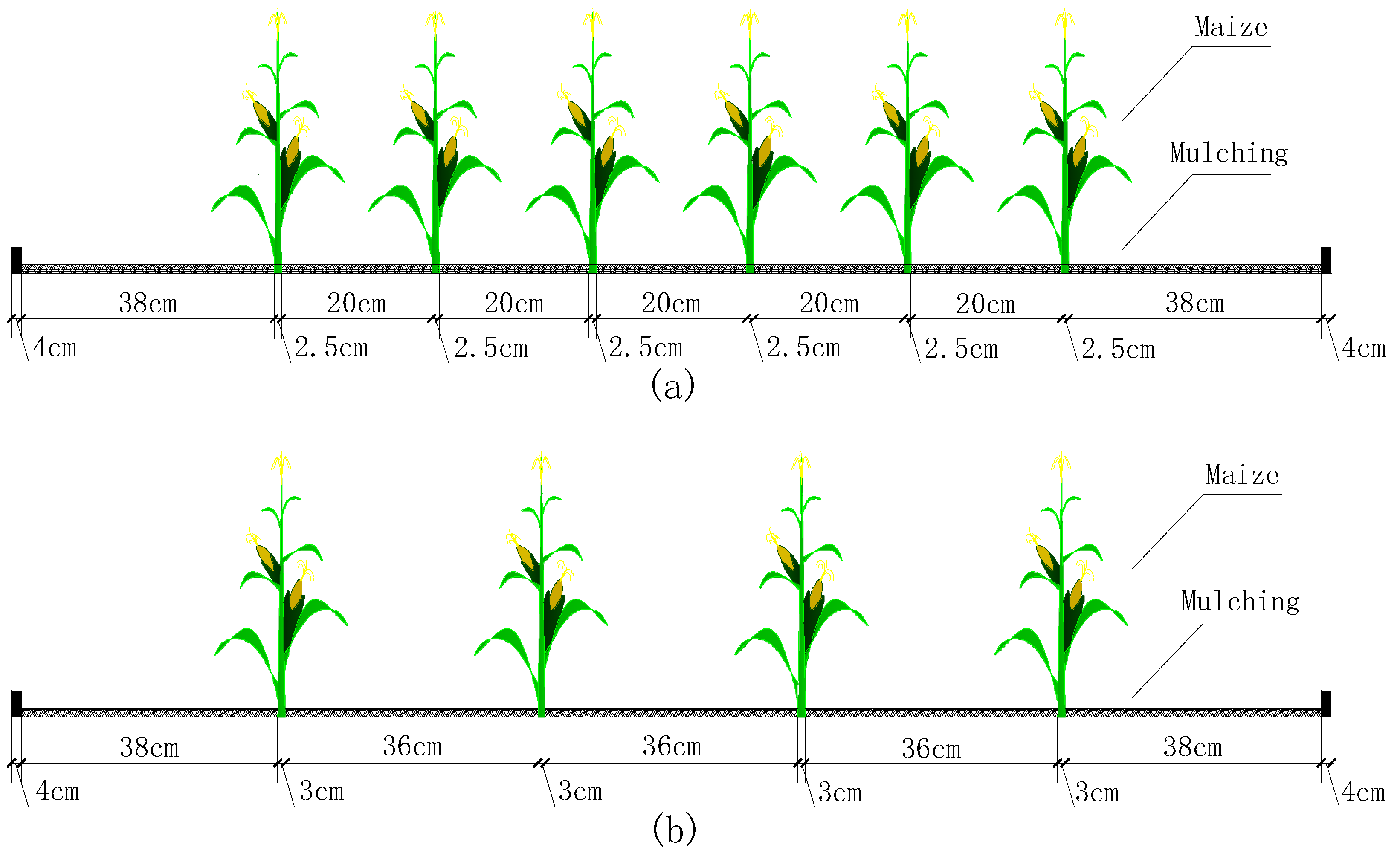

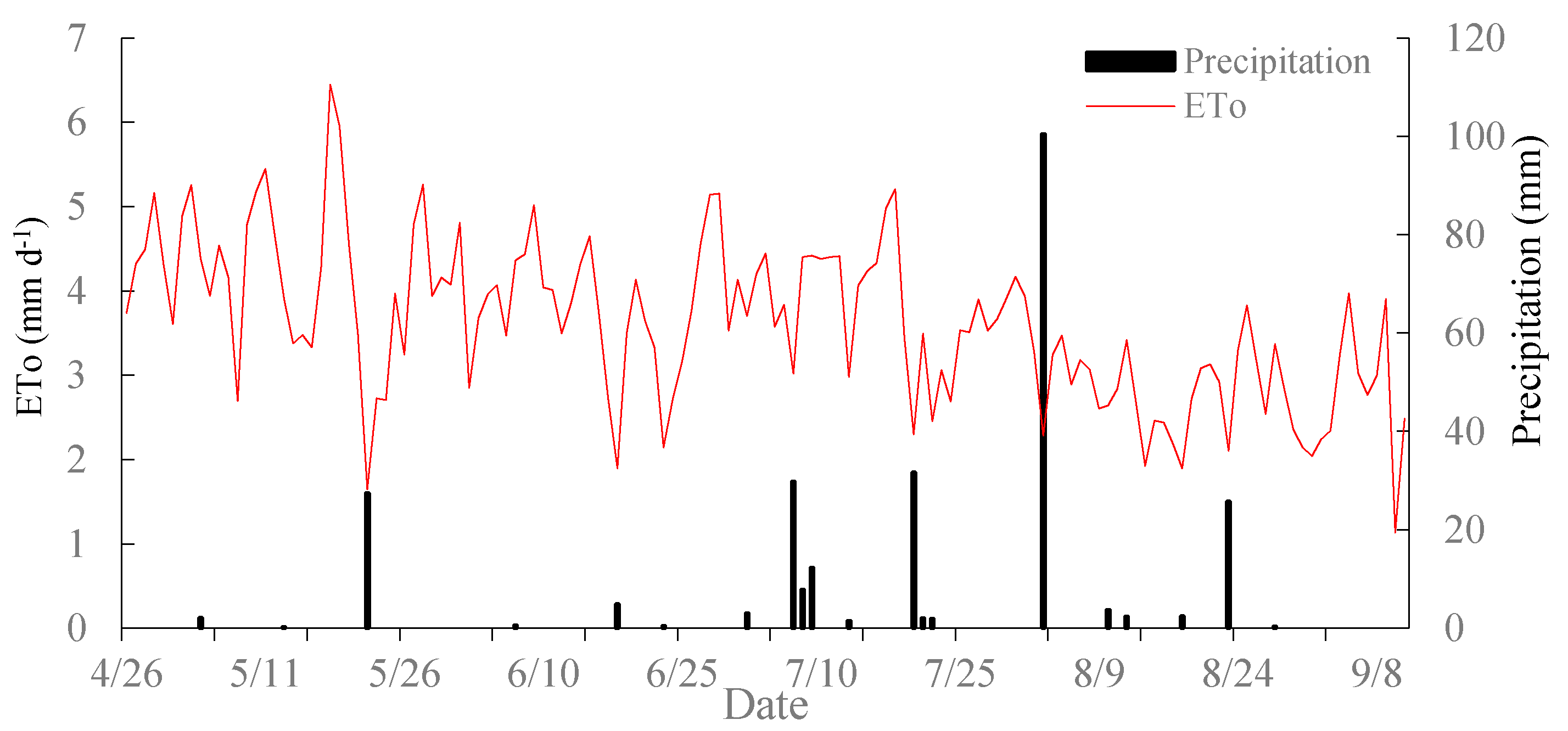
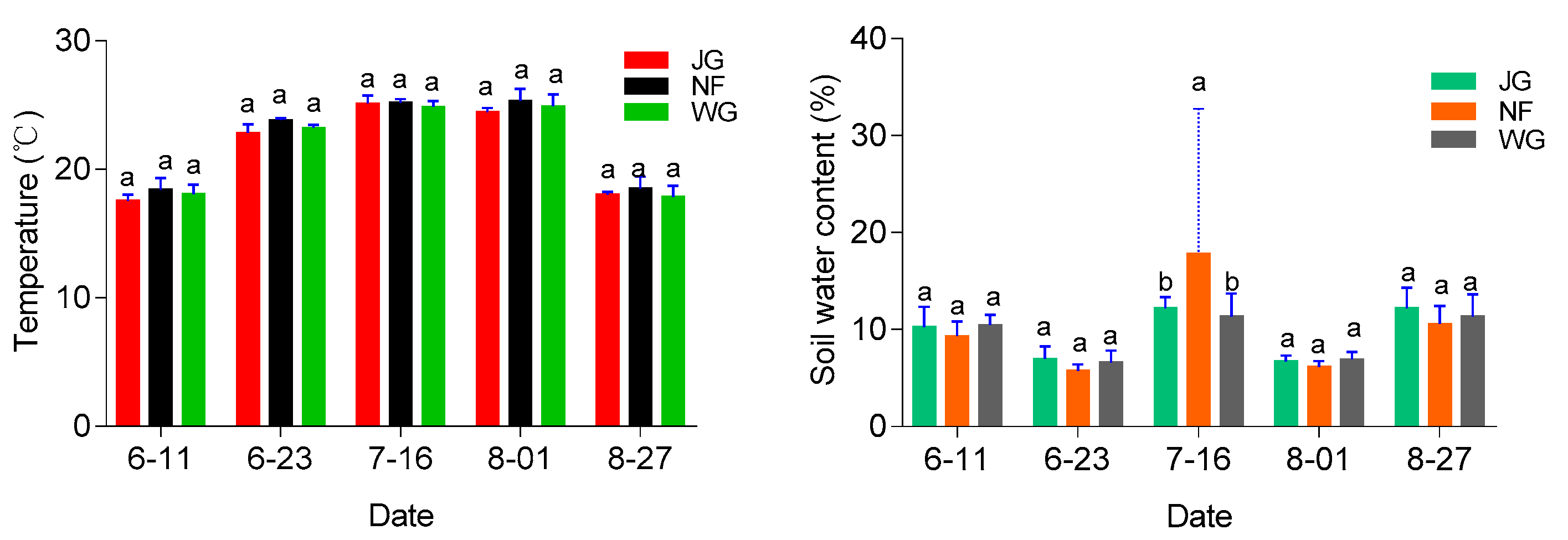

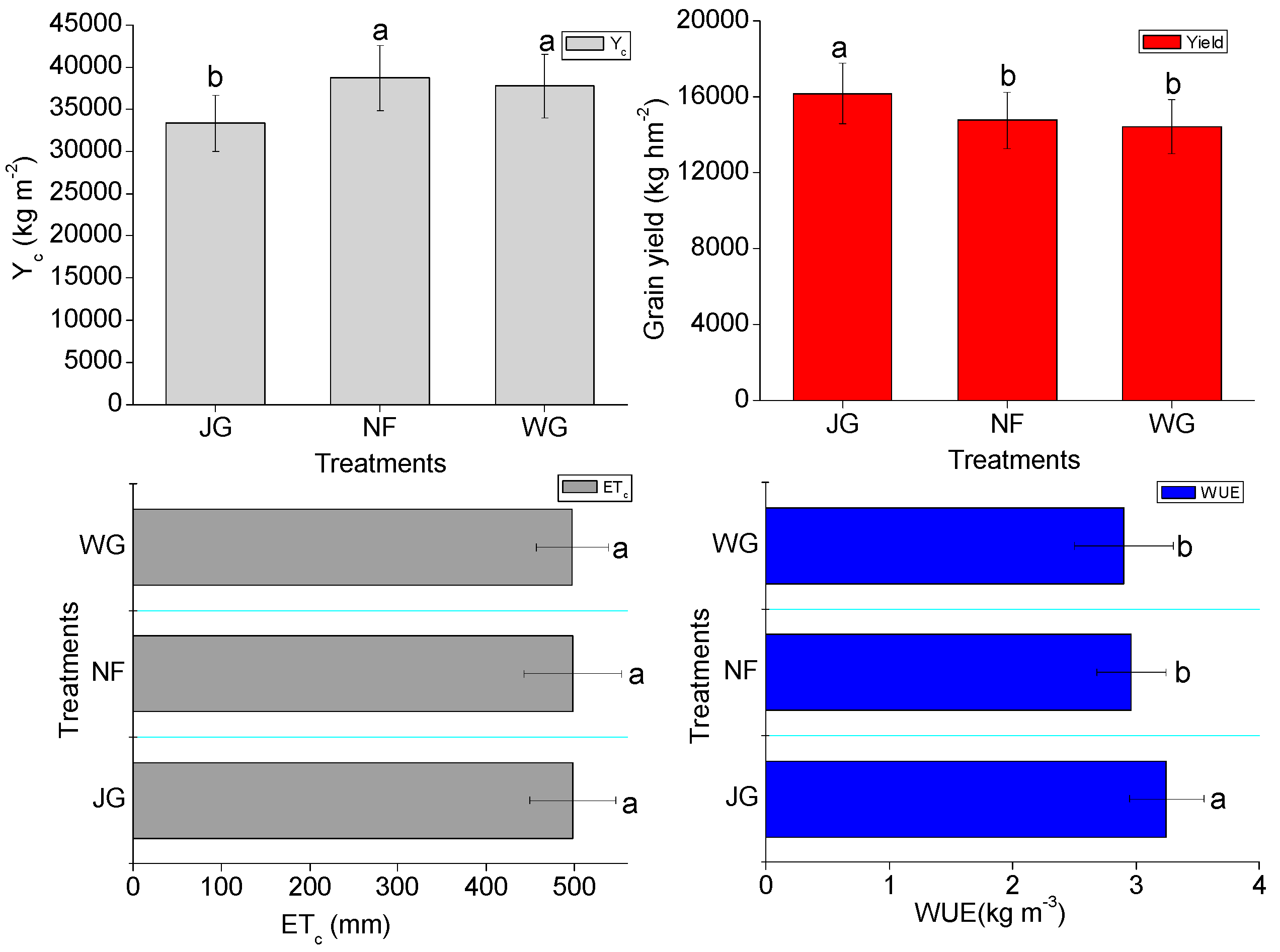
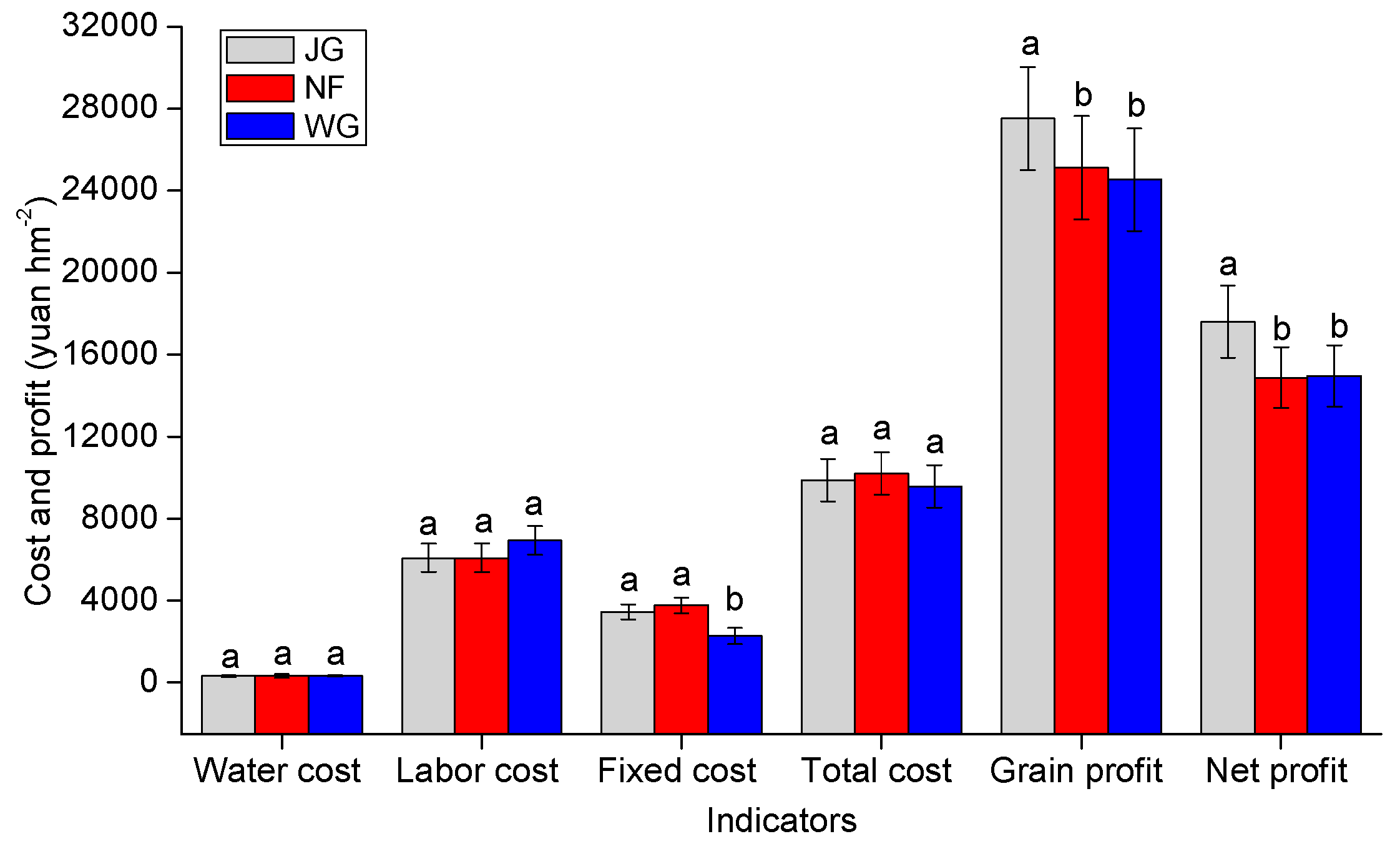
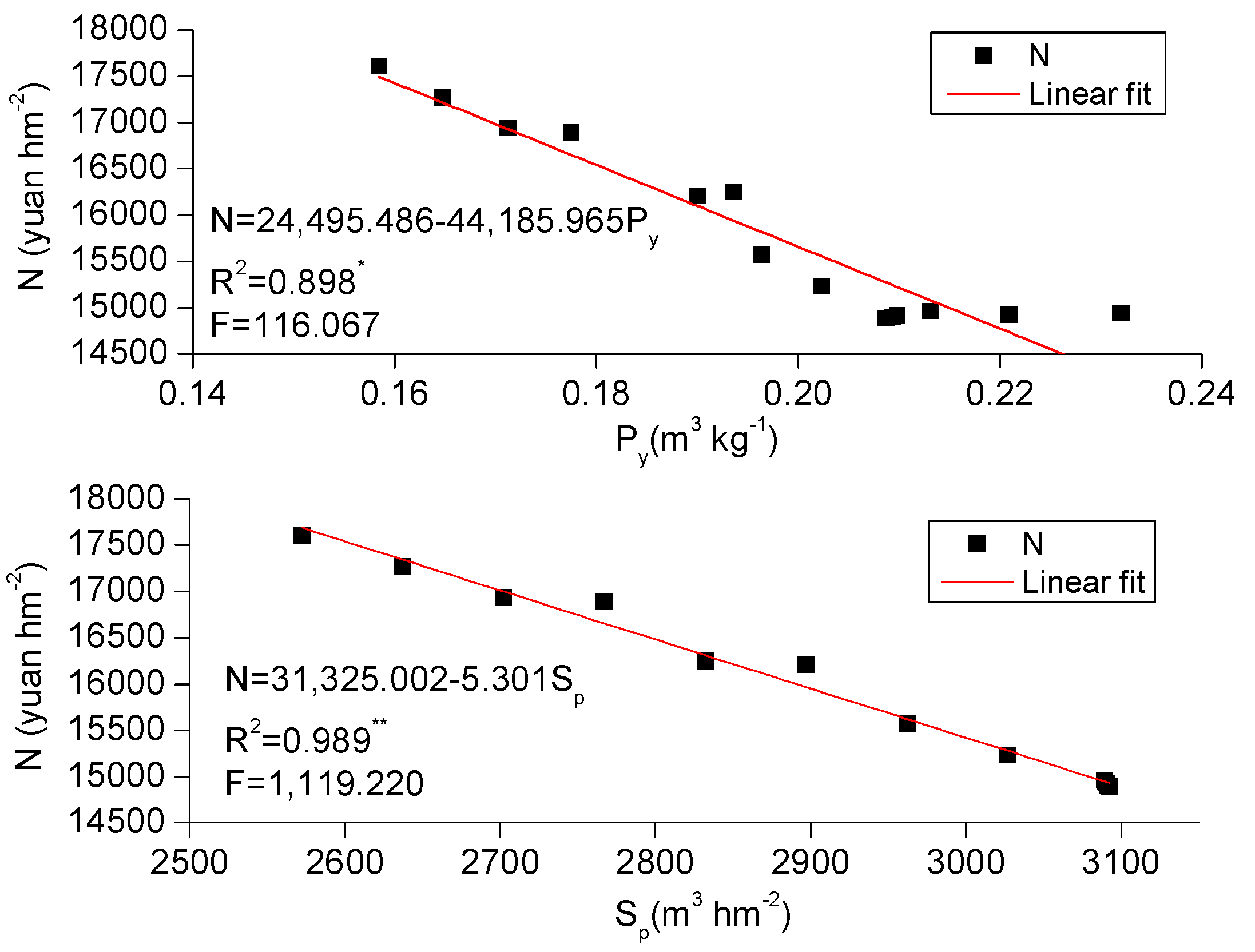
| Growth Stage | Precipitation | Irrigation Only | Straw Mulching (JG) | Organic Manure Mulching (NF) | No Mulching (WG) |
|---|---|---|---|---|---|
| Seeding-Jointing stage | 26 April–28 April | Covers all three treatments: 0.00 | |||
| 28 April–1 May | 38.97 | 38.76 | 39.13 | ||
| 2 May–22 May | Covers all three treatments: 29.90 | ||||
| 23 May–25 May | 5.94 | 6.02 | 5.98 | ||
| 23 May–8 June | Covers all three treatments: 0.60 | ||||
| Total Irrigation from Seeding to Jointing Stage | 74.81 | 74.72 | 75.01 | ||
| Irrigation Deviation | −0.19 | −0.28 | +0.01 | ||
| Jointing-Heading stage | 9 June–13 June | 87.06 | 86.95 | 87.10 | |
| 14 June–24 June | Covers all three treatments: 5.50 | ||||
| 25 June–27 June | 38.24 | 38.09 | 38.12 | ||
| 25 June–15 July | Covers all three treatments: 54.70 | ||||
| Total Irrigation from Jointing to Heading Stage | 185.50 | 185.24 | 185.42 | ||
| Irrigation Deviation | +10.50 | +10.24 | +10.24 | ||
| Heading-Filling stage | 16 July–20 July | 62.88 | 62.90 | 62.84 | |
| 20 July–28 July | Covers all three treatments: 35.70 | ||||
| Total Irrigation from Heading to Filling Stage | 98.95 | 98.60 | 98.54 | ||
| Irrigation Deviation | −11.42 | −11.40 | −11.46 | ||
| Filling-Ripening stage | 29 July–4 August | Covers all three treatments: 100.50 | |||
| 5 August–7 August | 4.38 | 4.44 | 4.40 | ||
| 5 August–8 September | Covers all three treatments: 34.80 | ||||
| Total Irrigation from Filling to Ripening Stage | 139.68 | 139.74 | 139.70 | ||
| Irrigation Deviation | −0.32 | −0.26 | −0.30 | ||
| Total Water Supply (Irrigation Plus Precipitation) in Whole Growing Season (No Decimals) | 500.00 | 500.00 | 500.00 | ||
| Total Precipitation in Whole Growing Season | Covers all three treatments: 261.60 | ||||
| Total Irrigation Only in Whole Growing Season (No Decimals) | 239.00 | 239.00 | 239.00 | ||
| Indicator | Model | Regression Coefficient | t | P | R2 |
|---|---|---|---|---|---|
| Py | (Constant) | 0.696 | 13.358 | 0.000 | 0.920 |
| Y | −3.320 × 10−5 | −9.648 | 0.000 | ||
| Sp | (Constant) | 299.478 | 102.482 | 0.000 | 0.988 |
| Yc | 0.057 | 2029.233 | 0.000 | ||
| Y | −0.151 | −1866.520 | 0.000 | ||
| ETc | −0.237 | 3.857 | 0.012 |
| Index | Treatment | Y (kg hm−2) | Index | Yc (kg m−2) | Y (kg hm−2) | ETc (mm) |
|---|---|---|---|---|---|---|
| Py (m3 kg−1) | JG | 0.951 * | Sp (m3 hm−2) | −0.982 ** | 0.905 * | 0.887 * |
| NF | −0.999 ** | −0.982 ** | −0.982 ** | −0.997 ** | ||
| WG | 0.982 ** | −0.817 * | 0.982 ** | 1.000 ** |
© 2020 by the authors. Licensee MDPI, Basel, Switzerland. This article is an open access article distributed under the terms and conditions of the Creative Commons Attribution (CC BY) license (http://creativecommons.org/licenses/by/4.0/).
Share and Cite
He, Z.; Shang, X.; Zhang, T. Study on Water Saving Potential and Net Profit of Zea mays L.: The Role of Surface Mulching with Micro-Spray Irrigation. Appl. Sci. 2020, 10, 402. https://doi.org/10.3390/app10010402
He Z, Shang X, Zhang T. Study on Water Saving Potential and Net Profit of Zea mays L.: The Role of Surface Mulching with Micro-Spray Irrigation. Applied Sciences. 2020; 10(1):402. https://doi.org/10.3390/app10010402
Chicago/Turabian StyleHe, Zhaoquan, Xue Shang, and Tonghui Zhang. 2020. "Study on Water Saving Potential and Net Profit of Zea mays L.: The Role of Surface Mulching with Micro-Spray Irrigation" Applied Sciences 10, no. 1: 402. https://doi.org/10.3390/app10010402
APA StyleHe, Z., Shang, X., & Zhang, T. (2020). Study on Water Saving Potential and Net Profit of Zea mays L.: The Role of Surface Mulching with Micro-Spray Irrigation. Applied Sciences, 10(1), 402. https://doi.org/10.3390/app10010402





